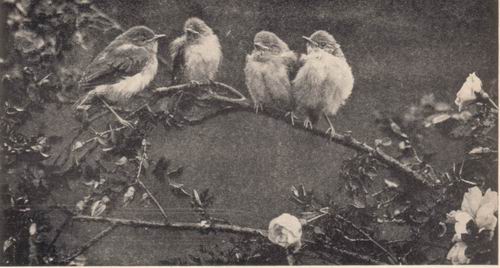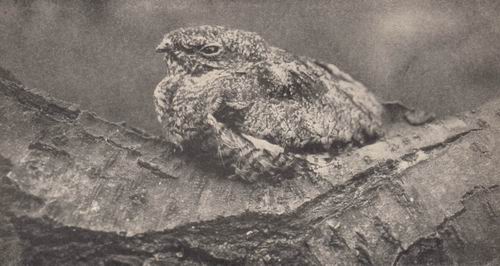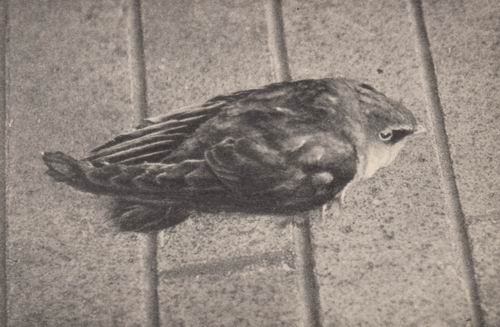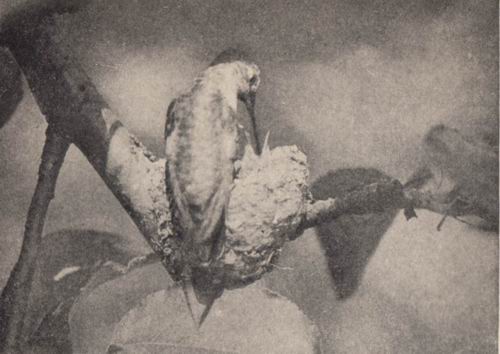|
1999-2004 (Return to Web Text-ures) |
Click Here to return to Birds Every Child Should Know Content Page Click Here to return to last Chapter |
 (HOME) |
|
1999-2004 (Return to Web Text-ures) |
Click Here to return to Birds Every Child Should Know Content Page Click Here to return to last Chapter |
 (HOME) |
|
CHAPTER XII
SOME QUEER RELATIONS WHIP-POOR-WILL NIGHTHAWK CHIMNEY SWIFT RUBY-THROATED HUMMINGBIRD WHIP-POOR-WILL A QUEER, shadowy bird, that sleeps all day in the dense wood and flies about through open country after dark as softly as an owl, would be difficult for any child to know were it not for the weird, snappy triplets of notes that tell his name. Every one knows him far better by sound than by sight. Whip-poor-will (chuck) whip-poor-will (chuck) whip-poor-will (chuck) he calls rapidly for about two hours, just after sunset or before sunrise from some low place, fluttering his wings at each announcement of his name. But you must be near him to hear the chuck at the end of each vigorous triplet; most listeners don't know it is there. You might be very close indeed without seeing the plump bird, about the size of a robin, who has flattened himself lengthwise against a lichen-covered branch until you cannot tell bird from bark. Or he may be on a rock or an old, mossy log, where he rests serene in the knowledge that his mottled, dull dark-brown, gray, buff, black and white feathers blend perfectly with his resting place. He must choose a spot broad enough to support his whole body, for, like his cousin, the nighthawk, and his more distant relatives, the humming! bird and the swift, his feet are too small and weak for much perching. You never see him standing erect on a twig with his toes clasped around it, but always squatting when at rest. A narrow white band across his throat makes his depressed head look as if it had been separated from his body -- a queer effect that may remind you of the Cheshire Cat in "Alice in Wonderland." The whip-poor-will's three outer tail feathers have white ends which help to distinguish him from the nighthawk. He has a funny little short beak, but his large mouth stretches from ear to ear, and when he flies low above the fields after sunset, this trap is kept open, like the swift's and the swallow's, to catch any night-flying insects-mosquitoes, June bugs, gnats, katydids and little moths that cross his path. Long, stiffened bristles at the ends of his mouth prevent the escape of a victim past the gaping trap. On the wing the bird is exceedingly swift and graceful. Some children mistake him for a bat or a nighthawk. Relying upon the protective covering of her soft plumage, the mother whip-poor-will builds no nest, but lays a pair of mottled eggs directly on the ground in the dark woods where a carpet of dead leaves and decayed wood makes concealment perfect. Not even the ovenbird contrives that a peep at her eggs shall be so difficult for us. It is next to impossible to find them. Unlike the wicked cowbird, who builds no nest because she has no maternal instinct, the whip-poor-will, who is a devoted mother, makes none because none is needed. Once I happened upon two fuzzy, dark, yellowish-gray, baby whip-poor-wills (mostly mouths) in a hollow of a decayed, lichen-covered log, which was their "comfy" cradle; but the frantic mother, who flopped and tumbled about on the ground around them, whining like a puppy, sent me running away from sheer pity. In the Southern States a somewhat larger whip-poor-will, but with the same habits, is known as chuck-will's-widow.  Least flycatchers in a rose bush.  Nighthawk resting in the sunlight
NIGHTHAWK
Called also: Bull-bat; Night-jar; Mosquito-hawk Did you ever hear a rushing, whirring, booming sound as though wind were blowing across the bung-hole of an empty barrel? The nighthawk, who makes it, is such a high flyer, that in the dusk of. the late afternoon or early evening, when he delights to sail abroad to get his dinner, you cannot always see him; but as he coasts down from the sky-not on a sled, but on his half-closed wings-with tremendous speed, the rush of air through his stiff, long wing feathers makes an uncanny, aeolian music that silly, superstitious people have declared is a bad omen. You might think he would dash out his brains in such a headlong dive through the air, but before he hits the earth, a sudden turn saves him and off he goes unharmed, skimming above the ground and catching insects after the whip-poor-will's manner. He lacks the helpful bristles at the ends of his fly-trap. Don't imagine, because of his name, that he flies about only at night. He is not so nocturnal in his habits as the whip-poor-will. Toward the end of summer, especially, he may be seen coursing over the open country at almost any hour of the day. Once in a while, as he hunts, he calls peent -- a sharp cry that reminds you of the meadowlark's nasal call- note. Presently, mounting upward higher and higher, at the leisurely rate of a boy dragging his sled up hill, he seems to reach the very clouds, when down he coasts again, faster than a boy's flexible flyer. Listen for the booming noise of this coaster! Evidently he enjoys the sport as much as any boy or girl, for he repeats his sky-coasting very often without having to wait for a snow-storm. Indeed, when winter comes, he is enjoying another summer in South America. Life without insects would be impossible for him. When he is coursing low above the fields, with quick, erratic, bat-like turns, notice the white spots, almost forming a bar across his wings, for they will help you to distinguish him from the whip-poor-will, who carries his white signals on the outer feathers of his tail. Both of these cousins wear the same colours, only they put them on differently, the whip-poor-will having his chiefly mottled, the nighthawk his chiefly barred. The latter wears a broader white band across his throat. His mate substitutes buff for his white decorations. Like the mother whip-poor-will, she makes no nest but places her two speckled treasures in some sunny spot, either on the bare ground, on a rock, or even on the flat roof of a house. Since electric lights attract so many insects to the streets of towns and villages, the enterprising nighthawk often forsakes the country to rear her children where they may enjoy the benefits of modern improvements. Both the nighthawk and the whip-poor-will belong to the goatsucker family. Did you ever hear a more ridiculous name? Eighty-five innocent birds of this tribe, found in most parts of the world, have to bear it because some careless observer may have seen one of their number flying among a herd of goats in Europe to catch the insects on them, just as cowbirds follow our cattle; and he imagined the bird was actually drinking the goat's milk!
CHIMNEY SWIFT
There are some children, and grown-ups, too, who persist in calling this bird the chimney swallow, although it is not even remotely related to the swallow family, and its life history, as well as its anatomy, are quite different from a swallow's, as you shall see. Down within some unused chimney, the modern babies of this soot-coloured, dark, grayish-brown bird first open their eyes. Old-fashioned swifts still nest in hollow trees or caves, but chimneys are so much more abundant and convenient, that up-to-date birds prefer them. Without stopping in their flight, the parent swifts snap off with their beaks or feet, little twigs at the ends of dead branches, and these they carry, one by one, into a chimney, gluing them against the side until they have finished an almost flat, shelf-like, lattice cradle. Where do they get their glue? Only during the nesting season do certain glands in their mouths flow a brownish fluid that quickly gums and hardens when exposed to the air. After nursery duties have ended, the gland shrinks from disuse. When the basket cradle has been stuck against a chimney-side, it looks as if it were covered with a thin coat of isinglass. On this lattice from four to six white eggs are laid. A friend, who innocently started a fire in his library one cold, rainy mid-summer evening, was startled and shocked when a nest and eggs suddenly fell on the hearth. He had no idea birds were nesting in his chimney. The rush of their wings he had thought was the wind. Of course the fire melted the glue, when down fell the cradle. Happily there were no "babies and all" to tumble into the flames.  A chimney swift at rest  Hummingbird pumping food into her babies' crops  Twin ruby-throats When the baby swifts are old enough to climb out of the lattice, they still cling near it for about a fortnight waiting for their wings to grow strong, before they try to leave the chimney. Apparently they hang themselves up to go to sleep. Shouldn't you think they would fall on the hearth down stairs? Doubtless they would but for their short, thin, stiff-pointed tail feathers which help to prop them up where they cling to the rough bricks and mortar of the chimney lining. Woodpeckers also prop themselves with their tail feathers, but against tree trunks. Not until swifts are a month old do the lazy little fellows climb out of their deep, dark cavern into the boundless sky, which is their true home. No birds are more tireless, rapid flyers than they. Their small feet, weak from disuse, could scarcely hold them on a perch. One day last July I picked up on the ground a young swift I thought had dropped from exhaustion in its first flight. As swifts had been nesting in one of the chimneys, I carried the young bird in my hand into the house, upstairs, out through an attic window onto the roof, climbed along the ridgepole in terror for my life, clinging by only one free hand to the peak of the roof, and at last reached the swift's chimney. Laying the sooty youngster on the stone chimney-cap I had crawled cautiously backward only a few feet, when lo! my charge suddenly bounded off into the air like a veteran to join a flock of companions playing cross-tag. As it wheeled and darted above the house, evidently quite as much at ease in the air as any of the merry, twittering company, don’t you believe it started the laugh on me? But what had brought so able a young flyer to earth? My wounded vanity tempts me to believe that it had really dropped from fatigue and, once on the ground, was unable to rise again, whereas it was comparatively easy to launch itself from the chimney-top. With mouths agape from ear to ear, the swifts draw in an insect dinner piecemeal, as they course through the air, just as the whip-poor-will, nighthawk and swallows do. Fortunate the house where a colony elect to live, for they rid the air of myriads of gnats and mosquitoes, as they fly about overhead, silhouetted against the sky. Early in the morning and late in the afternoon are their hours for exercise. You will think, perhaps, that they look more like bats than birds. Watch their rapid wing-beats very closely and see if you can settle the mooted question as to whether they use both wings at once, or first one wing and then the other in alternate strokes. After you have noticed their peculiar, throbbing flight, you will never again confuse them with the graceful, gliding swallows. Although the swift is actually shorter than a sparrow, its spread wings measure over a foot across from tip to tip. No wonder it can fly every waking moment without feeling tired, and journey from Labrador to Central America for a winter holiday.
RUBY-THROATED HUMMINGBIRD
What child does not know the hummingbird, the jewelled midget that flashes through the garden, poises before a flower as if suspended in the air by magic, thrusts a needle-like bill into one cup of nectar after another, then whirs off out of sight in a trice? It is the smallest bird we have. Suppose a fairy wished to pluck one for her dinner, as we should pluck a chicken; how large, do you think, would be the actual body of a hummingbird, without its feathers? Not much, if any, larger than a big bumble-bee, I venture to guess. Yet this atom of animation travels from Panama to Quebec or beyond, and back, again every year of its brief life, that it may live where flowers, and the minute insects that infest them, will furnish drink and meat the year around. So small a speck of a traveller cannot be seen in the sky by an enemy with the sharpest of eyes. Space quickly swallows it. A second after it has left your garden it will be out of sight. This mite of a migrant has plenty of stay-at-home relatives in the tropics-exquisite creatures they are-but the ruby-throat is the only hummingbird bold enough to venture into the eastern United States and Canada. What tempts him so fax north? You know that certain flowers depend upon certain insect friends to carry their pollen from blossom to blossom that they may set fertile seed; but did you know that certain other flowers depend upon the hummingbird ? Only his tongue, that may be run out beyond his long, slender bill and turned around curves, could reach the drops of nectar in the tips of the wild columbine's five inverted horns of plenty. The Monarda or bee-balm, too, hides a sweet sip in each of its red tubes for his special benefit. So does the coral honeysuckle. There are a few other flowers that cater to him, especially, by wearing his favourite colour, by hiding nectar so deep that only his long tongue can drain it, and by opening in orderly succession so that he shall fare well throughout the summer, not have a feast one month and a famine the next. In addition to these flowers in Nature's garden that minister to his needs, many that have been brought from the ends of the earth to our garden plots please him no less. The canna, nasturtium, phlox, trumpet-flower, salvia, and a host of others, delight his eye and his palate. Don't you think it is worth while to plant his favourites in your garden if only for the joy of seeing him about? He is wonderfully neighbourly, coming to the flower-beds or window-boxes with undaunted familiarity in the presence of the family. A hummingbird that lived in my garden sipped from a sprig of honeysuckle that I held in my hand: But the bird is not always so amiable by any means. A fierce duellist, he will lunge his rapier-like bill at another hummer with deadly thrusts. A battle of the midgets in mid-air is a sorry sight. You may know a male by the brilliant metallic-red feathers on his throat. His mate lacks these, but her brilliancy has another outlet, for she is one of the most expert nest builders in the world. An exquisitely dainty little cup of plant down, felted into a compact cradle and stuccoed with bits of lichen bound on by spider-web, can scarcely be told from a knot on the limb to which it is fastened. Two eggs, not larger than beans, in time give place to two downy hummers about the size of honey-bees. Perhaps you have seen pigeons pump food down the throats of their squabs? In this same way are baby hummingbirds fed. After about three weeks in the nest, the young are ready to fly; but they rest on perches the first month of their independence more than at any time afterward. No weak-footed relative of the swift could live long off the wing. It is goodbye to summer when the last hummingbird forsakes our frost-nipped, northern gardens for happier hunting grounds far away. |